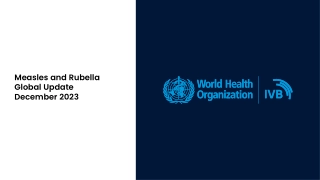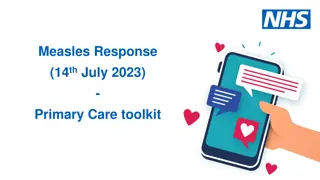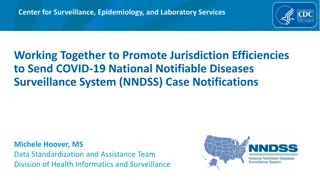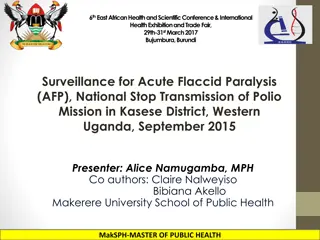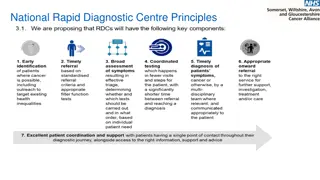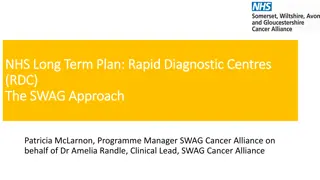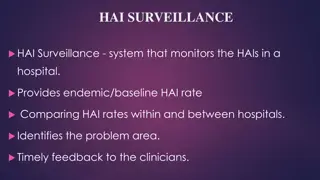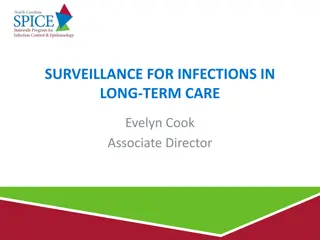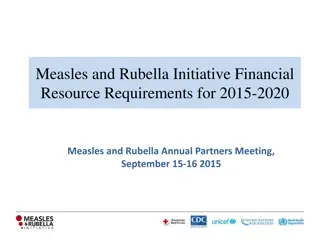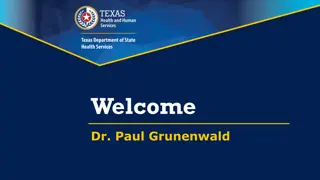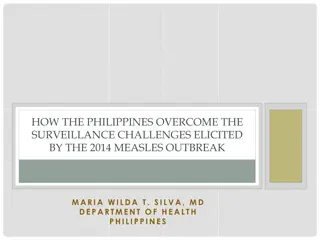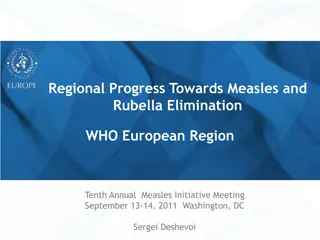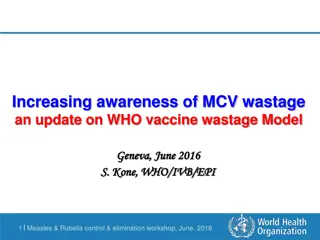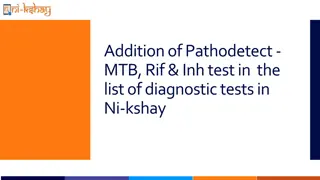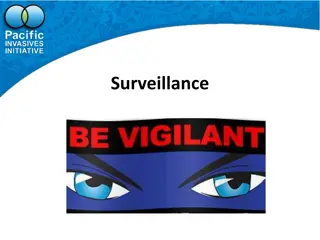Role of Rapid Diagnostic Test for Measles in Global Surveillance
Laboratory-based surveillance is crucial for monitoring and controlling measles outbreaks. The development of new tools like rapid diagnostic tests (RDTs) for measles diagnosis can revolutionize surveillance efforts. Challenges in introducing new diagnostics are discussed, along with the importance of accurate case definitions. Improvements in surveillance are essential for achieving global measles elimination goals.
Download Presentation

Please find below an Image/Link to download the presentation.
The content on the website is provided AS IS for your information and personal use only. It may not be sold, licensed, or shared on other websites without obtaining consent from the author. Download presentation by click this link. If you encounter any issues during the download, it is possible that the publisher has removed the file from their server.
E N D
Presentation Transcript
A Rapid Diagnostic Test for Measles Can it Transform surveillance? Measles & Rubella Initiative Partner Meeting, September 11,12 2019 Washington, DC.Dr David Brown, Consultant WHO IVB. Laboratorios de Flaviviruses, + Respiratorios e Samparo, FIOCRUZ, Rio de Janeiro Virus Reference Department, Public Health England
AIMS: Briefly describe key role of surveillance for measles programme, how we do laboratory based surveillance and why we need new approaches. Describe the development of new tools for measles diagnosis produced as part of a B&M Gates Foundation funded project. Review studies demonstrating RTD performance in Brazil and India and discuss some the challenges of introducing a new diagnostic. 2 An RDT for measles; implication for global surveillance
Surveillance of Measles Surveillance is Key to measure the impact of guide direction of the vaccination programme. To measure Population vaccine Coverage. Incidence of Measles cases Progress in measles control 2000-2017 Measles vaccination is one of the most cost effective PH interventions. Great progress-95% Reduction in Measles Deaths 2000-17. But much still to do-Estimates indicate still >100,000 Deaths due to measles annually. Measles Elimination achieved in 84 (43%)of countries.
Measles case definition is non-specific: Rubella Measles Dengue Measles case definition Case with fever of 38C, maculopapular rash,either cough, coryza or conjunctivitis, or any case which a physician thinks is measles HHV-6 Echoviruses Parvovirus B19 Others 4 4 A RDT for measles; implication for global surveillance
Laboratory diagnosis of measles is needed for surveillance Virus detectable by PCR in oral fluid Virus detectable in nasopharynx Virus detectable in blood Rash CD8 T cells IgG Relative levels CD4 T cels IgM Immunesuppression -14 -7 0 7 14 21 28 3 Days after onset of rash Infection Rash onset Diagnosis- serology IgM detection-Serum/EIA or Oral Fluid Molecular epidemiology: RT-PCR: (early samples) Oral fluid, T/S, urine, lymphocytes Virus isolation need Vero-SLAM cells for wild strains 5 A RDT for measles; implication for global surveillance
Current Laboratory diagnostic testing for measles . Collect blood sample National Measles laboratory Transport serum to Laboratory 1-?days Testing Target < 4days Public health response An RDT for measles; implications for global surveillance 6
Tracking measles strains The Measles Virus is serologically monotypic.( vaccine effective for over 50 years) Can detect differences in the genetic code of strains. (sequencing) To use in surveillance Measles community agreed a Common language to describe these differences to enable us to track transmission pathways. Genotypes are based on a standard window of 450bps, which varies by 12% between strains. In all 24 Genotypes have been described and accepted. 7 An RDT for measles; implications for global surveillance
Measles Virus Genotypes: Compare sequences to create a phylogenetic tree showing relationships between strains. Analogous to a Family tree. Montreal.CAN/89 D4 Victoria.AUS/12.99 D9 Palau.BLA/93 D5 Bangkok.THA/93/1 D5 Illinois.USA/89/1 D3 Manchester.UNK/30/94 D8 Genotyping: - Sequence 450bp of N gene 12% variation 8 clades: A H Illinois.USA/50.99 D7 Victoria.AUS/16.85 D7 Bristol.UNK/74 D1 NewJersey.USA/94/1 D6 Johannesburg.SOA/88/1 D2 MVi/Mpigi.UGA/18.00 D10 MVs/Madrid.SPA/94 F Erlangen.DEU/90 C2 Maryland.USA/77 C2 Tokyo.JPN/84/K C1 Goettingen.DEU/71 E Edmonston-wt.USA/54 A Libreville.GAB/84 B2 Yaounde.CAE/12.83 B1 NewYork.USA/94 B3.2 Ibadan.Nie/97/1 B3.1 24 genotypes: A, B1-B3, C1-C2, D1-D11, E, F, G1-G3, H1-H2 Hunan.CHN/93/7 H1 Beijing.CHN/94/1 H2 Berkely.USA/83 G1 Amsterdam.NET/49.97 G2 Gresik.INO/18.02 G3 0.01 8 8 A RDT for measles; implication for global surveillance
Distribution of measles genotypes from January 2018 to December 2018 inclusive (12 month period) Source: http://www.who-measles.org/Public/Data_Mnt/who_map.php Data source: MeaNS database for genotypes, IVB database for incidence 9 9 A RDT for measles; implication for global surveillance
Monitoring Measles Genotype disappearance- Global genotype detection 2008-2019 (Aug) 2008 2009 2010 2011 2012 2013 2014 2015 2016 2017 2018 2019 Genotype B2 1 12 52 7 387 (2) B3 17 94 336 1082 596 1494 566 721 2673 2995 970 D4 425 338 666 2026 927 134 41 66 53 15 19 2 D5 114 18 1 D8 76 37 96 246 832 1700 1223 1301 1552 2552 3748 3628 D9 26 28 41 225 91 79 91 33 96 46 D11 0 6 1 G3 0 0 25 51 1 15 5 H1 157 144 158 29 66 181 4850 3167 2599 544 348 24 10
Use of Measles Genotyping and Sequence Data, Molecular epidemiology Genotypes and Sequence Data Inform: Sustained transmission( endemic transmission) 1 strain in circulation for >1 year In elimination phase- Distinct pattern of small outbreaks caused by different strains, linked to imported cases. Limitations of Genotyping Tracking pathways becoming more difficult. Little diversity in outbreak setting Complex patterns of importation (multiple imports from one O/B) Future-Extended and Whole Genome Sequencing- increases resolution. 11 A RDT for measles; implication for global surveillance
Can rapid tests and alternative samples help overcome barriers to rapid comprehensive measles reporting? to program! Oral fluid and Capillary blood samples easier to collect , less invasive , will increase compliance. Timeliness of results. Surveillance is defined as information for action! Many programmes miss the 4 day reporting target for laboratory results. Shipping samples can be a challenge - geography, maintaining cold chain WHO -Only 3% of cases are reported Significant delays in outbreak confirmation delays initiating appropriate control measures An RDT for measles; implications for global surveillance 12 12 A RDT for measles; implication for global surveillance
Oralight OF collector New tools developed for B&M Gates M/R IgM RDT project 1. Oralight - new oral fluid collection device 2. Lateral Flow tests for use on serum, capillary blood and oral fluid. Tetanus toxoid specific IgG antibody. Measles specific IgG antibody. Measles and Rubella specific IgM antibody. 3. ESEQuant lateral flow reader/ mobile phone 13 A RDT for measles; implication for global surveillance
Using Oral fluid samples for measles diagnosis Advantage of oral fluid collection over serum Less invasive and reduced stress for patient and parent Easy to collect. Mother may collect and self collection possible for older children, under supervision Similar patterns of antibody to serum (gingival fluid is a transudate) Lower antibody level requires optimized assay for accurate results. IgG (mg/100ml) IgM (mg/100ml) Serum 1250 80 Whole Saliva 1.4 0.2 Parotid Saliva 0.04 0.04 Gingival Crevicular Fluid 350 25 Serum:Gingival Crevicular Fluid ratios 3.6:1 3.2:1 14 BMGF PHE RDT project final report: December 2018 An RDT for measles; implications for global surveillance An RDT for measles; implication for global surveillance 14
Oral fluid collection: Oracol Oracol Developments) successfully used since 1994 in UK(>200,000 cases investigated) device (Malvern Medical Limitation: Requirement for sending to laboratory for extraction and testing An RDT for measles; implications for global surveillance 15 A RDT for measles; implication for global surveillance 15
Oralight: Packaged for use Oralight Oral Fluid collector provided sterilized with instructions for use. A RDT for measles; implication for global surveillance An RDT for measles; implications for global surveillance 16
Extracting oral fluid from the Oralight 1. Device 3. Flip open primary lid 2. Add extraction buffer (1ml). Push down swab and tighten screw cap to squeeze OF into tube 4. Invert and dispense OF into test device or for storage 3. 1. 2. 17 An RDT for measles; implications for global surveillance 17 An RDT for measles; implication for global surveillance 4.
Oralight: Usability and Safety Study: Entebbe, Uganda. OF collected using both devices from 154 children 6-59 months. Usability: Comparable performance sample volume, IgG level. No problem in using either Oralight or Oracol devices but some preference for Oracol due to need to hold cap of Oralight Oralight initially felt drier in the mouth than Oracol Extracted Oralight fluid contained more particulate material than Lab processed Oracol sample Safety: Blood contamination in 4.5% of Oracol and 7% in Oralight Contributing factors: Status of teeth/oral hygiene, over vigorous rubbing of gums with devices No evidence of discomfort or bleeding on review 5 mins and 30 mins after collections. Oracol is CE marked, used for >20 years An RDT for measles; implications for global surveillance 18 A RDT for measles; implications for global surveillance 18
A point-of-care test (RDT) for measles diagnosis: detection of measles-specific IgM antibodies and viral nucleic acid - Warrener et al: Bull World Health Organ 2011 Components of the point-of care test (RDT) and examples of signal intensities obtained during RDT testing of sera from four patients and of the cut-off control serum Main findings: With serum, RDT showed a sensitivity and specificity of 90.8% (69/76) and 93.6% (88/94), respectively. With oral fluids, sensitivity and specificity were 90.0% (63/70) and 96.2% (200/208), respectively. Both H and N genes were reliably detected in RDT strips and the N genes could be sequenced for genotyping. Measles virus genes could be recovered from RDT strips after storage for 5 weeks at 20 25 C. An RDT for measles; implications for global surveillance 19 19 A RDT for measles; implication for global surveillance
Capture format lateral flow assay gold-labelled antigen and anti-human IgM test line Direction of reagent flow Add sample OF/ blood Gold labelled measles N antigen Control line: Antibody: anti- microbial antigen Test line : anti-human IgM Plastic backing card Cotton linter paper wick Nitrocellulose membrane Blood separation pad Conjugate release pad
Measles IgM RDT evaluation in Rio: Results: RDT vs Lab EIA 125 sera from Brazilian surveillance system, Positive and negative for measles IgM, 28 dengue IgM positives. Used WHO 4 point Visual scoring scale : 2 being interpreted as positive for measles IgM in the RDT,Control line consensus visual scoring 2 being considered as valid. Concordance: 96.0% (120/125) Sensitivity: 96.1% (74/77) Specificity: 100% (46/46) Good correlation (97%, Kappa 0.95) with the ESEQuant suggest the measles RDTs are usable without the reader if necessary. An RDT for measles; implications for global surveillance 21 21 A RDT for measles; implication for global surveillance
Reading RDT in the Field- study designs used, based on results of Brazilian study. Visual reading: independently by two trained staff at 20 minutes. Record result. Invalid tests and tests giving discordant results repeated. Record result using a mobile phone camera. Image can be sent to National laboratory for review if doubts/ disagreement about result. Scan used devices with ESEQuant on receipt of RDT at reference laboratory. 22 An RDT for measles; implications for global surveillance 22 A RDT for measles; implication for global surveillance
NPSP, Uttar Pradesh, India 2017-2018: Measles IgM RDT evaluation. Evaluation of RDT device under field conditions for measles diagnosis and genotype determination. Ethics and ICMR approval 2 day training for 15 district surveillance team. All collections by surveillance team 757 subjects recruited using normal surveillance criteria-with suspected measles cases having rash onset previous 4-28 days. 8 subjects from each of at least 75 outbreaks. OF, capillary blood and venous blood samples collected from all cases. Usability and feasibility data collected. Similar study in Uganda -380 cases recruited 2018. An RDT for measles; implications for global surveillance 23 A RDT for measles; implication for global surveillance 23
Comparing True Positives Vs RDT True positive cases were then defined as: Positive results in Siemens IgM EIA assay, or, N gene positivity in Oral Fluid sample True positives Vs CBRDT: True Positives Vs OFRDT: CBRDT Obs 1 OFRDT Obs 1 Pos Equiv Neg Pos Equiv Neg True cases True cases True case 507 35 20 True case 412 81 63 Undefined* 1 3 10 Undefined* 2 2 9 Negative 6 9 142 Negative 8 11 139 733 727 Sensitivity 96% Sensitivity 87% Specificity 96% Specificity 95% Equivocal results excluded from these calculations. PCR result led to the re-classification of 26 Siemens EIA equivocal or neg cases as true positives An RDT for measles; implications for global surveillance 24 24 A RDT for measles; implication for global surveillance
Measles H gene PCR positive RDT vs Measles IgM positive RDT: N=197, UP, India 100 Proportion of PCR positive vs IgM positive 90 80 70 60 50 Cap Blood 40 OF PoCT 30 20 10 0 <7 8-14 15-21 22-28 Sample collection: Range of days post rash onset Data from NPSP, India, 2017 25 25 A RDT for measles; implication for global surveillance 25 An RDT for measles; implications for global surveillance
Performing the measles IgM RDT in the field Indis 2017 RDT Test lines scored as: Negative = 0 Equivocal =1 Positive = 2+ weak, 3+ moderate, 4+ strong OF sample Capillary sample An RDT for measles; implications for global surveillance 26 26 A RDT for measles; implication for global surveillance
Conclusions: Measles IgM RDT using serum and CAP has similar performance to Siemens EIA / serum for case confirmation. Using OF samples it is 10% less sensitive. PCR on used RDT is positive in >90% of used IgM positive OF/RDT and 50% CAP/RDTs in early samples . Introduction would enhance the sampling frame for Molecular epidemiology studies . RDTs for Malaria, HIV widely used in clinics. In our studies both approaches were successfully introduced following short training and were preferred by surveillance staff and parents to blood collection. The successful introduction of the technologies developed in this project has the potential to transform measles surveillance: A point of care test for real time case confirmation 20 Mins! using Measles IgM, which can be used to trigger early public health response . An RDT for measles; implications for global surveillance A RDT for measles; implication for global surveillance 27 An RDT for measles; implications for global surveillance 27
FOUR Pilot studies now established to address feasibility of introducing RDT use into MR surveillance program, 2019. Status Notes Malaysia In process (pre-RDT period-300+ cases recruited). Use of RDT underway following training in August n=450, includes impact on reporting times and PH response. Uganda Study underway following training in July, RDT testing established in level 3,4 clinics in 6 districts in Uganda. n=200, Clinic based CB includes impact study, economic evaluation, internet based reporting. Control phase setting. Brazil Planned Improved flexibility for Lab-based (in state labs), testing serum from surveillance cases. O/B investigations following reintroduction of measles Cameroon Training complete- April 2019. Lab-based, testing serum from surveillance; some feasibility assessment. Control phase Ghana Training may 29,30, 2019 Lab-based, testing serum from surveillance; some feasibility. Control phase. An RDT for measles; implications for global surveillance A RDT for measles; implication for global surveillance 28 28
Future plans and issues NOT yet available. Project to Commercialise and gain regulatory approval is under review. Project also aims to produce a Rubella IgM RDT Device received with enthusiasm at all study sites. Only risk identified so far will introduction reduce case reporting to national surveillance How should the RDT be used in Measles surveillance ?(WHO WG) -Replace Lab tests at national laboratory? -Move testing to the clinic? -Endemic measles tranamission and/or Elimination phase? A RDT for measles; implications for global surveillance 29
Acknowledgements: B&M Gates Foundation David Brown Dhan Samuel Lenesha Warrener David Featherstone Ben Childs Maddison designs, CARCLO swab manufacture Keith Perry Kevin Brown Field Studies: Uganda Josephine Bwogi, Anatoli Kamali Theopista Kabaliisa Henry Bukenya Peter Eliku. Brazil Marilda Siqueira India Lucky Sangal Sunil Bahl Ashutosh Abhishek Ashok Diamond 30 A RDT for measles; implication for global surveillance 30


